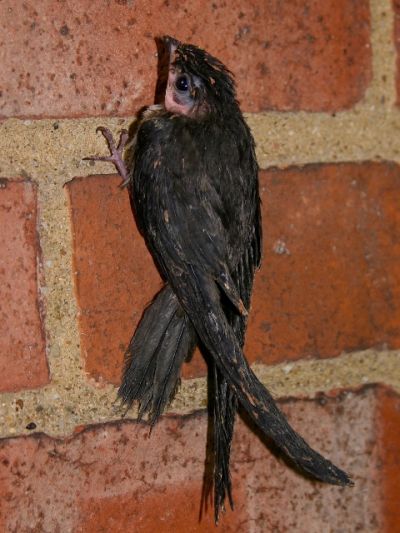 The chimney swift flocks have grown again after weeks of reduced numbers. Since the swifts arrived last spring I’ve seen the character of their flocks change four times.
The chimney swift flocks have grown again after weeks of reduced numbers. Since the swifts arrived last spring I’ve seen the character of their flocks change four times.
First, the flocks were made up of spring migrants who chittered and ate on the way to their final destination.
The second phase was courtship in which trios flew synchronously, chittered loudly and completely followed each others’ moves. Eventually those trios became pairs as the females chose mates.
During the nesting phase the flock was cut in half because one adult of each pair was always in the chimney incubating, brooding or tending the young. The smaller flock wasn’t nearly as noisy. No need to shout, the courting is over.
And now the babies are fledging and the flock is double or triple in size and noise.
It’s fun to watch the fledglings learn to eat on the wing. They still expect their parents to feed them so they follow them closely and beg a lot but their parents don’t stop. The adults lead them through clouds of insects and the babies, whose mouths are probably open to beg, are stunned to find insects pop into their mouths. All they have to do is swallow.
Soon they are swerving and chasing insects on their own. It won’t be long before they’re as skilled as their parents and become indistinguishable as members of the flock.
(photo by Chuck Tague of a rescued chimney swift just before it fledged)
I watch swifts every Tuesday evening as they vanish into a chimney of a local business. It’s fascinating to watch the aerial ballet around the stack. And suddenly they all plummet into the chimney and hundreds are gone within 3 minutes. Even the kids are fascinated by this (shock!)
Do they really nest in chimneys? What happens when the owner of the house decides to use the chimney… odd as that may be in the middle of summer?
Yes, they really do nest in chimneys. When the owner of the chimney decides to fire it up, the birds die. If the owner decides to clean the chimney or, in the case of an abandoned building, tear it down the babies are lucky if they get rescued. The chimney swift pictured here was one of those who had to be rescued. I hear from Chuck Tague that this swift was taken to ARL’s Verona Wildlife Center where it was fed, nursed and released. Chuck was involved with this release a few years ago.
There was a Chimmy cleaning at my next door neighbor and the two small birds fell to the bottom, one looked hurt the other doing well. The owner of the company told me they were baby sparrows so I looked up what I can feed a baby sparrow. That wasn’t the case, they were indeed Chimmy Swifts and I gave the one thriving wet dry cat food, so it wood survive, my bad!
Also the Chimmy guy being in the business over 40 years should have know this bird.
I ended up bring the birds to the animal hospital and the Dr. Confirmed they were Chimmy Swifts. And she would reach out to the Wild life rehabilitation. I feel so terrible as I’m now seeing the mom and dad looking for them. The Chimmy is now caped and they wouldn’t have
Access to them if they were left inside! Hope I did the right thing.
But now I have educated myself about this beautiful bird.
Can John English tell us where this “local business” is? I’d go there swiftly (pun intended) to watch! And I’m not even a kid! Anne
Lol Anne. There’s a brass foundry on Ardmore Blvd. at Braddock Rd. Next to Forest Hills Presbyterian Church. Park in the church lot and look for the chimney on the foundry.
Try the South Side too – though I can’t tell you an exact chimney. Lots of chimney swifts there – and lots of chimneys.
There is a school on Rt 50 in Carnegie where my daughter’s high school football team used to play (I think it was Carnegie’s high school before they merged the school districts, and it is still the district’s high school field). Several times over the years we saw huge flocks (I mean hundreds of birds) dive into a chimney in the school building at dusk, as we were watching the football game. It was an amazing site. I always assumed that they were migrating flocks…you wouldn’t see such a large group otherwise, I wouldn’t think.
You’re righ that the huge flocks happen during migration – which will start in just 3-4 weeks. Something to look forward to!
We rescued a pre-fledging chimney swift that had fallen out of the nest to the bottom of the chimney (no longer in use) of our furnace. Now what?
Take it immediately to a rehabber near you! It needs to eat frequently!
If you live in the Pittsburgh area, take it to the ARL Verona Wildlife Center, 6000 Verona Rd, 412-793-6900. If not in Pittsburgh, find a rehabber in your area. Good luck!
Cold, early winter coming. My kitchen chimney (old style cooking fireplace with large stone chimney) is a staging site for the migration. Last week had 500 -600 birds roosting every night. They left yesterday.
Normal departure date is 3rd week of September. Last time they left this early was before the winter of 76/77.